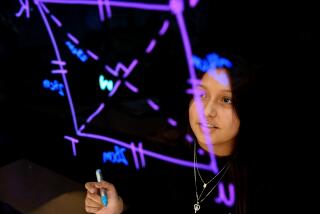Technology Labs: Wood Shops of the ‘90s : Education: Local computer training programs teach students skills they’ll need in a high-tech work force.
Through the mist of a humidifier, eighth-graders Chas Kindschi and Jon Spencer followed the path of the red laser beam as it shot across their desk.
A few feet away, classmate Rodrigo Flores designed a greeting card with a computer keyboard, mouse and graphics software.
And behind a soundproof window, a trio of 14-year-olds were wiring together a mini-recording studio so they could play DJ and mix a tape of their favorite songs.
“We just have to act like we’re a radio station and we get graded on it,” explained eighth-grader Karl Hauser.
In the room that once housed a wood shop at Sequoia Intermediate School, such disparate assignments are by design.
Called the Technology Lab, the room is outfitted with four kinds of computers and a dozen work stations, all of which offer links to high-tech careers.
For future draftsmen and architects, there is a computer program allowing students to build three-dimensional homes. For automotive engineers, there is a computer-linked wind tunnel to measure drag on model cars. And for future magazine designers, there is a desktop publishing program.
“We can’t do everything they’re doing in industry, but we’re exploring it,” said Sequoia teacher Lee Drawn, who has worked for three years to bring the Technology Lab program to Thousand Oaks.
*
While Sequoia’s program is aimed at giving all middle-school students a taste of technology, a Technology Lab at Newbury Park High School will give teen-agers a chance to focus on specific skills.
Next year, seventh- and eighth-graders taking the class at Sequoia will spend five days on each of the work stations, also called modules. At Newbury Park, students can opt to spend an entire quarter on projects in just one or two areas.
In addition, the high school will also offer a semester-long course next year in computer repair.
Teacher Bob Hendricks said he volunteered to set up and teach Newbury Park’s Technology Lab program because of what it could offer teen-agers not planning to attend college.
“I thought we were becoming too elitist,” said Hendricks, who also teaches world history. “Too much attention was being focused on college-bound kids and not enough was being done for non-college-bound students.
“When I first started 26 years ago, we had a metal shop, a wood shop and other crafts,” Hendricks added.
*
Now, however, some of those electives are offered only at one high school or have been cut altogether.
Richard Nicholson, president of the California Industrial and Technology Education Assn., said the pressure to cut out traditional industrial-arts electives has helped spawn Technology Labs throughout the state.
With the loss of one-subject electives, Technology Labs are seen as a way to pack more options into a single class. They also grew in popularity, Nicholson said, as school districts acknowledged the need to better prepare students for tomorrow’s jobs.
“The new tools are not the hammer and the bench vise. It’s a keyboard, a mouse, a monitor, a robotic arm,” he said. “The tools have changed, so we just need to change with the times.”
Throughout the state, about 300 middle schools now operate high-tech classrooms, he said. Approximately 100 high schools have similar programs or are in the process of developing them.
In Ventura County, the Ventura Unified School District has been a leader in the movement. Five years ago, the district outfitted DeAnza Middle School with a $120,000 high-tech classroom. Since then, more of the high-tech classrooms have been built for less money, and by next fall all of the district’s middle schools should have them.
Tom Stoddart, director of vocational education for Ventura schools, said the program’s benefits go beyond exposing students to new careers.
Though no formal studies have been done, teachers have noted that students in the high-tech classrooms have a lower absentee rate and fewer discipline problems, he said.
“When I go out to the labs unannounced, I always see students on task,” he said. “They’re not screwing around and throwing things.”
The biggest obstacles that districts face in setting up high-tech classrooms, Stoddart said, are funding and resistance from longtime industrial arts teachers who feel threatened by computers.
“The problem we had at first was trying to get instructors to change their line of thinking on technology. But once they’re hooked, they’re born-again teachers,” he said.
*
Nicholson said districts typically spend between $30,000 and $80,000 to renovate and purchase equipment for the high-tech classrooms.
In Thousand Oaks, school officials spent between $35,000 and $40,000 to equip the two rooms at Sequoia Intermediate and Newbury Park High School, which were ready in mid-March. Much of the renovation was done by district employees and some computers already owned by the schools were incorporated. By the fall, Hendricks and Drawn said the number of work stations will be expanded from 12 to 17.
“We’re trying to do this on a shoestring,” Hendricks said.
In addition to exposing students to new career options, the Technology Labs are one way the Thousand Oaks district is heeding the demands of parents anxious for their children to become computer literate. If the program is successful, school officials say they hope to expand the two-campus pilot project to other sites.
Some students complained recently that they feel like “guinea pigs” in the new classes. Others said they like the variety and the chance to work with a partner.
“It’s a cool class,” said 14-year-old Jason Woods, a pupil of Drawn’s who was using Lego-like blocks to experiment with levers and pulleys. “It’s a little tough, but it’s OK.”
More to Read
Inside the business of entertainment
The Wide Shot brings you news, analysis and insights on everything from streaming wars to production — and what it all means for the future.
You may occasionally receive promotional content from the Los Angeles Times.










